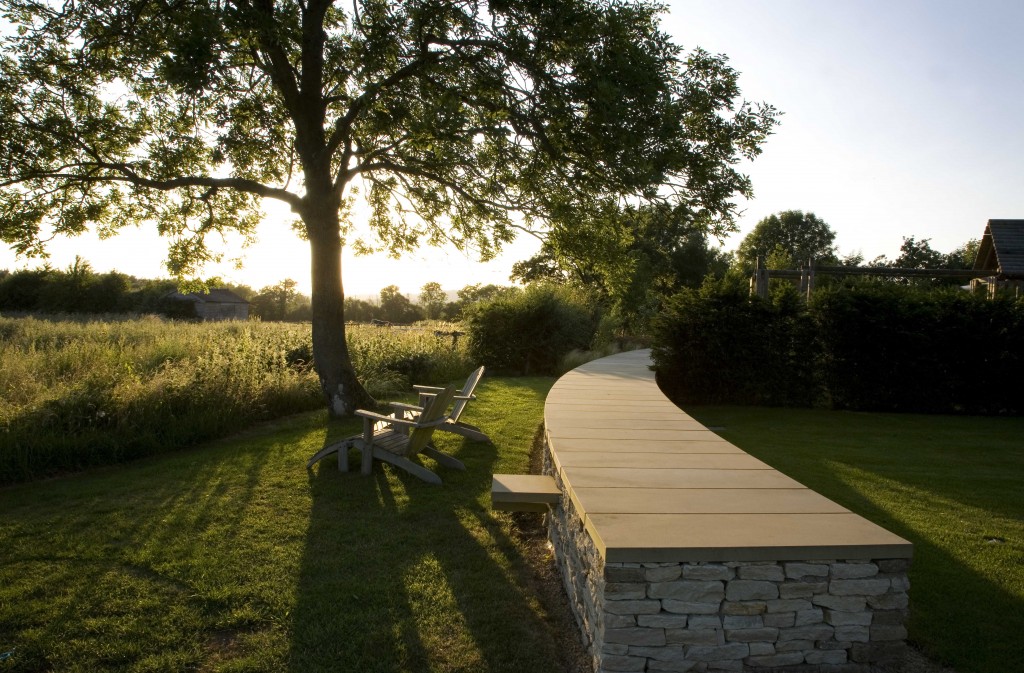A few months ago I was asked by a magazine to explain the differences between a garden designer, a landscape designer and a landscape architect. They were writing a piece on designers and the research had led them in a number of different directions. I was immediately intrigued: not only was this is an interesting question, but I instinctively felt that it was one that I am probably quite well placed to answer, as I am both a landscape architect and garden designer as well as having a lot of involvement in contracting. What I felt was interesting about the question was that to define the terms, one has to return to the root definitions – what is a garden? What is a Landscape?
(see the project page on the Bowles & Wyer website for the scheme above)
Let’s start with garden design. Everybody knows what a garden is, don’t they? Here are some definitions from the web:
1. A plot of ground, usually near a house, where flowers, shrubs, vegetables, fruits, or herbs are cultivated.
2. A piece of ground or other space, commonly with ornamental plants, trees, etc., used as a park or other public recreation area: a public garden.
3. A fertile and delightful spot or region.
Let’s ignore the third one for a moment (although it is interesting – cultural references to paradise). With regards to the first two definitions, there are two common elements: boundaries and the act of cultivation. The words ‘plot’ and ‘a piece of ground’ imply distinct limits to the space as opposed to a landscape which has much looser limits, or no limits at all. Note that plants and the intervention of a ‘gardener’ are (for the purposes of these definitions) a pre-requisite. So without humans, gardens revert to landscape. I love the idea that for something to be considered a garden there has to be a gardener: there is a poetic circularity in the definition. Also note that the definition mentions ‘usually near a house’, although I would stretch this cover any building. And a garden designer designs gardens – simple (although some get involved in other things as well).
Landscape architecture is a completely different story. Instead of thinking of it as one discipline, I view it as an umbrella profession that covers a very wide range of areas of expertise in a similar way to say medicine, or law. In practice, landscape architecture covers landscape planning, environmental impact analysis, landscape character analysis, strategy and masterplanning, and so forth. Landscape design is the design element of landscape architecture; some would argue that garden design is a branch of landscape design. Landscape design is different from garden design in a number of ways, mostly by the reverse of the definitions we looked at above:
- Scale – landscape design covers projects that are generally of a larger size (but can also be small).
- Context – gardens are normally (although not always) associated with a building, landscapes need not be, in fact frequently are not.
- Generally, gardens have defined boundaries, landscapes often don’t.
- There is almost always an element of management or maintenance (‘gardening’) involved in gardens. This can also apply to landscape, but need not and is a less important element.
There is one really simple definition of landscape – anything that is not in a building. Landscape design is clearly the design of the landscape. By this definition, garden design could be said to be a specialism of landscape design. It is not less of a skill for that, if anything the reverse. There is ‘nowhere to hide’ in garden design. Every element is important and there is no chance of fudging the design. The shift in scale is difficult for many landscape architects to cope with, just as many garden designers struggle with master-planning. So although the two disciplines are clearly related, the area of overlap is not as large as one might at first think.

